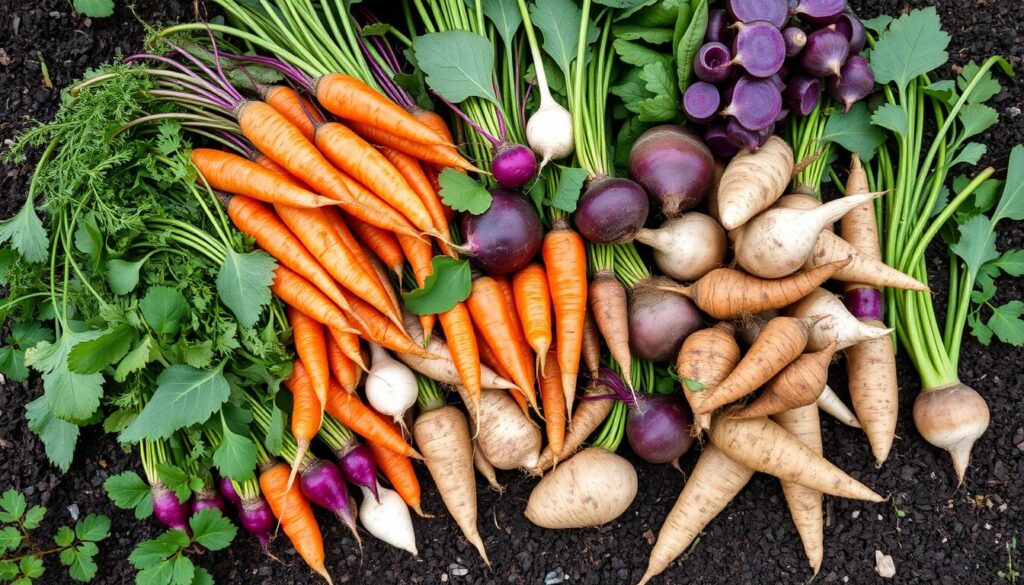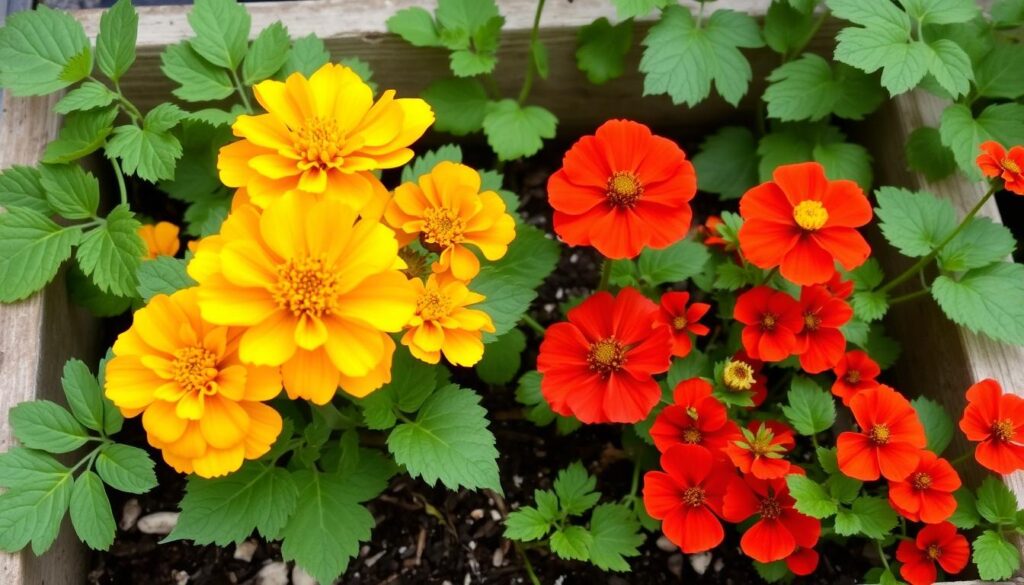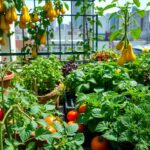The Best Vegetables for Small-Space Gardens: High-Yield Varieties You Need to Grow
Feeling limited by your small garden or growing space? Don’t let that stop you from enjoying a bountiful harvest! Discover the best vegetables to grow in compact areas. Maximize your yield, no matter the size of your outdoor oasis.
Key Takeaways
- Compact vegetable varieties thrive in small spaces and raised beds
- Container gardening opens up new possibilities for urban and balcony growers
- Leafy greens and root crops provide high yields in limited areas
- Space-saving tomatoes and peppers can be grown vertically
- Succession planting and companion planting techniques optimize your small garden
Maximizing Space in a Small Garden
Working with a small garden means picking the right plants. Choose compact vegetable varieties and use container gardening to make the most of your space. This way, you can grow a lot of food in even the smallest areas.
Compact Vegetable Varieties
For small gardens, try determinant tomatoes, bush beans, and small root vegetables like carrots and beets. These plants grow well in tight spaces and produce a lot. By picking these varieties, you can fill your garden space and get a big harvest.
Container Gardening Solutions
Container gardening is great for city gardeners. You can use patios, balconies, and small yards for growing. Use vertical gardening with trellises and hanging baskets for plants like tomatoes, peppers, and leafy greens. This way, you save space and grow a lot of food in a small area.
| Compact Vegetable Varieties | Container Gardening Techniques |
|---|---|
|
|
By using the right plants and container gardening, you can make your small garden very productive. You’ll get a lot of food, even with a tiny garden.
Best vegetables for small gardens
Small-space gardening means picking the right vegetables is key. Focus on high-yield, space-saving crops that do well in small areas. Leafy greens, root crops, tomatoes, peppers, and squash are great for small gardens.
Leafy greens like kale and Swiss chard are perfect for small gardens. They’re packed with nutrients and can be picked over and over. Compact root vegetables, such as carrots and beets, also do well in tight spaces, giving you a big harvest from a little space.
Tomatoes and peppers are excellent for small gardens too. Choose determinate or dwarf tomato varieties and compact pepper plants for a big crop without taking up much room. Squash is another great choice, fitting well in raised beds or containers.
To make the most of your small garden, pick the right vegetable varieties and use space-saving methods. Try vertical gardening and raised bed gardening. With some planning and the right choices, you can have a thriving garden even in a small space.
| Vegetable | Characteristics | Best Varieties for Small Gardens |
|---|---|---|
| Leafy Greens | Nutrient-dense, cut-and-come-again harvests | Kale, Swiss Chard |
| Root Crops | Compact growth, high yields | Carrots, Beets |
| Tomatoes | Prolific producers, space-saving varieties | Determinate, Dwarf |
| Peppers | Bountiful harvests, compact plants | Compact, Container-Friendly |
| Squash | High yields, versatile growing options | Bush, Patio |
Choosing the best vegetables for small gardens lets you enjoy a big harvest in a small space. Focus on high-yield, space-saving crops and use techniques like raised bed gardening to boost your productivity.
Leafy Greens for Cut-and-Come-Again Harvests
Leafy greens are perfect for small gardens. You can keep picking their leaves without pulling out the whole plant. This way, you get a steady supply of fresh, healthy greens from a small garden.
Kale: Nutrient-Dense and Prolific
Kale is a top pick among leafy greens. It’s packed with vitamins, minerals, and antioxidants. This tough plant does well in small spaces, giving you many harvests over a long season. Its big, pretty leaves make your garden look great too.
Swiss Chard: Vibrant and Versatile
Swiss chard is great for small gardens too. Its big, colorful leaves and crunchy stems add texture and taste to your meals. It’s perfect for salads or sautés, making your dishes look and taste amazing.
Adding these cut-and-come-again leafy greens to your garden means you’ll have fresh, tasty produce all season. Kale and Swiss chard are excellent for making the most of your garden space.
High-Yield Root Crops
Root vegetables are great for small gardens. They grow down, not out, making them perfect for tight spaces. Carrots and beets are top choices for small gardens.
Carrots: Sweet and Crunchy
Carrots are a favorite in small gardens. They fit well in shallow containers or raised beds. Varieties like ‘Parisian’ and ‘Nantes’ are made for small spaces.
Carrots are sweet, crunchy, and full of nutrients. They’re essential for any garden that saves space.
Beets: Nutritious and Flavorful
Beets are great for small gardens too. They give you tasty roots and leaves that are good for you. Beets come in many colors, like red, yellow, and striped.
Types like ‘Chioggia’ and ‘Bull’s Blood’ work well in containers or raised beds.
Choosing carrots, beets, or both can make your small garden very productive. You’ll get lots of tasty, healthy vegetables to enjoy.

Space-Saving Tomatoes and Peppers
In small-space gardens, tomatoes and peppers are great choices. They grow well in small areas and give you lots of tasty produce. These space-saving crops are perfect for small gardens.
Determinate or “bush” tomatoes are great for containers and raised beds. They don’t spread out like some other tomatoes. Look for varieties like ‘Patio’, ‘Tiny Tim’, or ‘Tumbling Tom’ to save space.
Peppers are also great for small gardens. They come in many sizes, shapes, and colors. You can grow them in pots, hanging baskets, or small beds. Try ‘Redskin’, ‘Banana Supreme’, or ‘Miniature Bell’ for a small garden.
| Crop | Recommended Compact Varieties | Ideal Growing Conditions |
|---|---|---|
| Tomatoes |
|
|
| Peppers |
|
|
Choosing the right tomato and pepper varieties lets you have a big harvest in small spaces. These space-saving crops are perfect for small gardens. They grow well and offer many options.
Vertical Gardening Techniques
If you have limited gardening space, think about looking up. Vertical gardening lets you use your space well and grow more. You can use trellises for climbing plants and grow plants in hanging baskets.
Trellising Vining Crops
Vegetables like cucumbers, pole beans, and indeterminate tomatoes spread out a lot. By giving them a trellis to climb on, you save space and make picking easier. This method also helps with air flow.
- Build a strong trellis, fence, or teepee for the vines to climb on.
- Help the plants wrap their tendrils around the trellis as they grow.
- Pick vining plants that work well with trellises, like pole beans, cucumbers, and indeterminate tomatoes.
Hanging Baskets for Small Spaces
Using hanging baskets is another smart way to save space. You can grow plants like strawberries, cherry tomatoes, and herbs up high. This frees up space on the ground.
- Choose light, trailing plants for hanging baskets, such as strawberries, cherry tomatoes, and herbs.
- Use potting mix that drains well and make sure the baskets have holes for drainage.
- Put the hanging baskets in sunny spots that are protected from the wind.
With these vertical gardening tips, you can make the most of your small garden. You’ll get a lot of harvest even in small spaces.
Succession Planting for Continuous Harvests
To make the most of your garden, try succession planting. This means planting new crops where old ones have been picked. It keeps your garden always busy. By planting different vegetables at different times, you get fresh produce all season.
Succession planting is great for small gardens. It helps you use every inch of your garden well. With some planning and timing, you can have a lot of homegrown food from spring to fall.
- Begin with a planting calendar to plan your succession. Pick the crops you like and know when they mature.
- Plant quick-growing crops like lettuce, radishes, and spinach where early vegetables like peas or broccoli were.
- After picking the first crops, plant more seeds or transplants. This keeps your garden always growing and producing.
- Try different crops and planting times to find what works best for your garden.
With creativity and succession planting, your small garden can be full of continuous harvests. Use your space well and enjoy a full season of fresh vegetables from your garden.
Companion Planting for Pest Control
Gardening in small spaces can be tough, but smart strategies help. One great way is companion planting. This means growing plants together to help each other out. By picking the right plants, you can keep pests away and grow a healthy garden.
Marigolds and Nasturtiums: Natural Pest Deterrents
Marigolds and nasturtiums are top choices for keeping pests away. They make your garden look great and keep pests off your veggies and herbs. Marigolds keep aphids and spider mites away with their strong smell.
Nasturtiums also keep pests like aphids and whiteflies away. They grow around your veggies, making a barrier that pests don’t like. Plus, their bright flowers draw in good bugs that eat pests.
Using companion planting with marigolds and nasturtiums makes your garden better. You won’t need harsh chemicals or a lot of work. It’s a natural way to make your garden more productive and peaceful.

“Companion planting is a time-honored technique that allows gardeners to work with nature, not against it, to create a flourishing, low-maintenance garden.”
Conclusion
Choosing the right vegetable varieties and using smart space-saving methods can make your small garden thrive. You can grow everything from leafy greens and root vegetables to tomatoes and peppers in a small area. With some planning and creativity, even a tiny outdoor spot can become a garden full of fresh produce.
If you live in the city or have a small backyard, this article offers great tips for small gardens. It talks about growing vegetables in containers and using vertical gardening. You’ll learn about succession planting and companion planting to keep pests away. These methods can make your garden productive and full of life, even in a small space.
With the right techniques, even a tiny garden can be a success. Enjoy the benefits of urban gardening and taste the difference of eating your own fresh produce. It’s a great way to make the most of your outdoor space.
FAQ
What are the best vegetable varieties to grow in small gardens?
How can I maximize my limited garden space?
What are some high-yield vegetables that thrive in small gardens?
How can I use companion planting to control pests in my small garden?
What techniques can I use to grow vegetables vertically in a small garden?
How can I ensure a continuous harvest in my small garden?
Source Links
- Most productive vegetables for limited space? – https://plantvillage.psu.edu/posts/4433-general-most-productive-vegetables-for-limited-space
- 14 Vegetables to Grow In A Small Garden – https://greensideup.ie/vegetables-to-grow-in-a-small-vegetable-garden/
- 17 High Yield Vegetables to Grow in Small Space Gardens – Gardeners’ Magazine – https://gardenersmag.com/high-yield-vegetables-to-grow-in-small-space-gardens/
- 10 Must-Have Blooms for Your 2025 Garden
- The Health Advantages of Gardening You Need to Know
- How to Create a Small Vegetable Garden Layout Plan: A Beginner’s Guide
- DIY Garden Projects for Small Spaces: Upcycling Ideas to Maximize Your Garden
- Watering Techniques for Small Gardens: Ensuring Your Plants Thrive
- Small Border Plants for Landscaping: Adding Beauty and Functionality to Your Garden
- Year-Round Small Space Gardening: Seasonal Planting Tips for Maximum Harvest
- Essential Tools for Small-Space Gardening: What You Really Need
- The Ultimate Guide to Container Vegetables: What to Grow in Small Spaces
- Budget-Friendly Gardening: How to Create a Thriving Garden on a Tight Budget
- How to Optimize Sunlight in Small Gardens: Tips for Better Plant Growth
- DIY Vertical Planters: Creative Ideas for Small Space Gardening
- Companion Planting for Small Vegetable Gardens: Boost Growth and Deter Pests
- Container Gardening Essentials: Choosing the Right Pots, Soil, and Plants
- Vertical Gardening Techniques: Maximizing Your Small Space with Climbers and Vines
- How to Build a Raised Bed Garden in a Small Backyard: Step-by-Step Guide
- The Best Vegetables for Small-Space Gardens: High-Yield Varieties You Need to Grow
- Smart Vegetable Garden Layouts for Small Spaces: Maximizing Your Green Thumb in Compact Areas
- 40. Best Practices for Managing a Sustainable Garden Year-Round
- Building a Wildlife Pond for Biodiversity
- Advanced Techniques in Sustainable Gardening
- How to Create a No-Till Garden
- The Mental Health Benefits of Gardening
- Using Technology to Enhance Sustainable Gardening
- Getting Certified Organic: Steps and Benefits

Leave a Reply